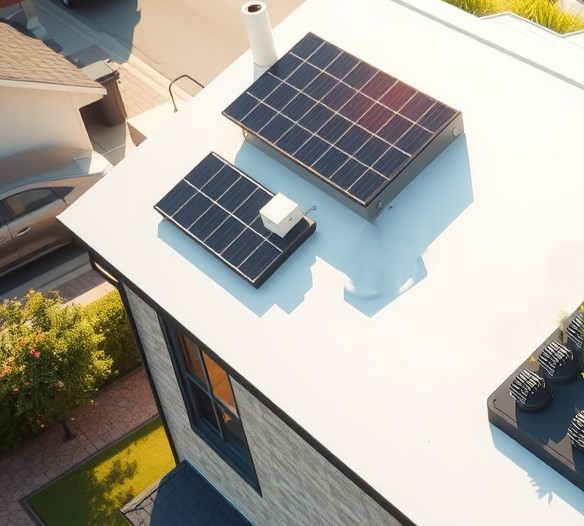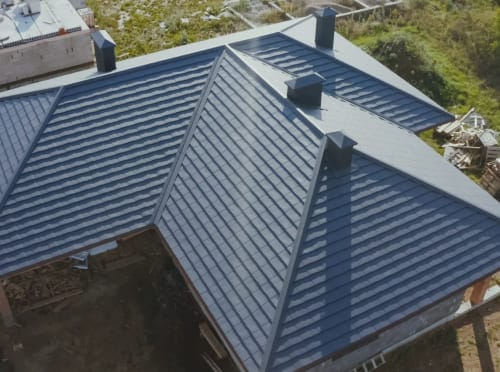At JP Carroll Roofing, we believe energy-efficient roofing is one of the smartest investments you can make. Choosing an energy-efficient roof isn’t just a home improvement—it’s a vote for a healthier planet. Every decision—from the materials you use to the color and technology you install—has the potential to lower emissions and support a more sustainable future.
In this article, we’ll explore how a modern, eco-conscious roof can reduce emissions, improve your comfort, and even help fight climate change.
Choosing Roofing Materials With Earth in Mind
An energy-efficient roof is designed to do 3 things exceptionally well: reflect sunlight, reduce heat absorption, and keep indoor temperatures steady.
Reflective materials bounce back sunlight instead of soaking it up, while high-quality insulation traps warm air in the winter and keeps it out in the summer, which cuts the energy your HVAC system needs to stay balanced. That means fewer fossil fuels burned, fewer greenhouse gas emissions, and lower monthly utility costs. By switching to energy-efficient roofing, homeowners can enjoy reduced costs for heating and cooling.
If you are struggling to choose the best roofing system and materials for your home and the environment, here are a few eco-friendly choices to consider.
Cool roofs
We often think of energy efficiency as a personal benefit—lower bills, increased comfort, better resale value. However, eco-wise roofs also offer real community-wide benefits. Have you ever noticed how city air feels hotter? If so, then you’ve experienced the urban heat island effect, and traditional roofing options are one of the many causes of it.
Urban heat islands happen when the many heat-absorbing surfaces trap heat and (like blacktop and dark roofs) cause a city or densely packed neighborhood to be hotter than surrounding areas. It’s not unusual for some cities to be 15 to 20 degrees hotter than more suburban areas. Temperatures can even vary from one block to the next.
Cool roofs help to reduce the urban heat island effect. These roofs use coatings or materials that bounce solar energy back into the atmosphere and include a broad category of light-colored or highly reflective roofs.
White roofs can reflect up to 90% of sunlight. They also stay cooler, which means they expand and contract less than darker roofs exposed to constant heat. This helps them last longer, reducing the frequency of roof replacements and the landfill waste that comes with them.
By reducing the need for air conditioning, cool roofs lighten the load on the power grid, which releases fewer pollutants into the atmosphere. One cool roof can reduce a single-story home’s cooling needs by 15% each year. When many homes adopt energy-efficient roofs, temperatures across entire neighborhoods start to drop.
Green roofs
Some homeowners are going even further and transforming their roofs into living landscapes. Green roofs—layered systems that support vegetation—don’t just look great. They help capture rainwater, provide natural insulation, and promote biodiversity in urban areas.
A well-designed energy-efficient roof can clear 90% of debris from rainwater before it enters your storage tank, offset up to your outdoor water usage in warmer months, reduce runoff, and lessen strain on city sewer systems during heavy storms. In cities like Providence and Boston, green roof installations—roofs layered with plant life—can reduce peak rain runoff by up to 90% and prevent sewer overflow into rivers and harbors.
Smart roof technology
Smart roofs are one of the most exciting developments in energy-efficient design. They combine real-time technology with responsive systems that actively manage your home’s temperature, moisture levels, and energy usage.
Here’s how smart roofs work for the environment:
- Sensors can track changes in temperature, humidity, and sunlight in real-time to adjust your home’s heating and cooling systems
- Some smart roofs sync with solar panels to monitor energy production, detect shade, and reroute power for energy efficiency
- Smart ventilation systems remove moisture and let your attic breathe without leaking energy, while high-quality insulation traps warm air in the winter and keeps it out in the summer
Metal, clay, and concrete tiles
Clay and concrete tiles, naturally insulating and made from abundant resources, hold up in extreme weather and provide excellent thermal regulation.
Metal roofing materials are highly reflective, durable, and recyclable. Some metal roofs last over 50 years—more than double the lifespan of standard asphalt shingles. Metal also performs better under UV exposure, resisting the wear and tear that shortens other roofs’ lives.
Recycled shingles repurpose plastics, rubber, and post-consumer waste, turning what would end up in landfills into functional, eco-friendly roofing.
Asphalt shingles
One of the biggest challenges with traditional asphalt roofing is heat retention. On a hot summer day, attic temperatures can soar above 140°F. That heat seeps into the living space, forcing your air conditioning to work overtime—and costing you more in energy and environmental impact.
Additionally, while traditional asphalt shingles might be cheap, their lifespan is shorter than many eco-friendly alternatives. Although they’re recyclable, about 11 million tons of asphalt shingles are sent to landfills each year.
That’s why at JP Carroll Roofing, we install Energy Star®-certified Energy Star® asphalt shingles designed with special reflective granules that reduce attic heat and lower cooling costs. These shingles reflect up to 20% of solar energy, compared to just 3% with traditional options. And for over 25 years, we’ve recycled all tear-off shingles and metal, keeping tons of roofing waste out of landfills.
A Greener Tomorrow Starts Today
When you install an energy-efficient roof, you’re not just investing in your home—you’re protecting the environment for future generations. Whether you’re interested in cool shingles, metal systems, or green roof designs, there’s an option that meets your needs and supports your values.
Let JP Carroll Roofing help you find the best energy-efficient roofing solution for your home. With over decades of service and a deep commitment to sustainability, we’re proud to build roofs that are smarter, stronger, and better for the world we share.
Ready to protect your home and the environment? Contact JP Carroll Roofing today and let’s build a roof that works for your home—and the planet.


